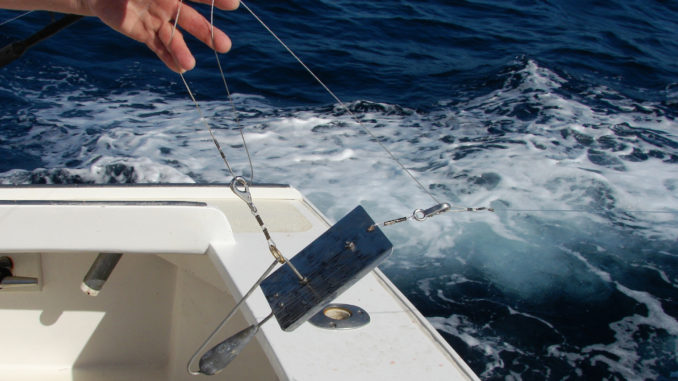
While wahoo are often caught by baits and lures running at or just below the surface, a good number are caught well below the surface on outfits designed to fish there. Trolling weights, planers, weighted lines and wire lines are all ways to get baits to troll below the surface.Marty Hiatt, mate on the Run Off, uses a special outfit, designed with a bridle in the line to allow a planer to be easily added to and removed from the trolling line. He said in addition to being able to add or remove the planer at will, this allows him to infinitely control the depth and doesn’t require another rod or a downrigger with a release to use the planer.
Hiatt begins his bridle rig by adding a 2-foot piece of 49-strand cable at the end of the line from the reel. This cable has eyes on both ends and finishes at approximately 18 inches once both eyes are made and crimped in place. There must be an inch or so more distance than between the snaps on the planer so it will fully engage and trip. The cable is small and flexible enough it can be wound through the rollers on the rod and onto the reel.
At the trailing eye of the wire, Hiatt adds a fluorocarbon topshot of approximately 125 feet, with a snap swivel at the far end. The leader with the lure and/or bait is attached to this snap swivel. When fishing for wahoo or other toothy critters, this leader is usually wire to help prevent bite offs.
Any planers to be used with this bridle rig must be rigged accordingly. They are rigged with a short piece of heavy fluorocarbon leader and a small, heavy-duty stainless steel snap on the ring that slides on the main brace and a second piece of short heavy fluorocarbon leader and small heavy duty stainless steel snap attached to the grommet at the rear of the planer. Hiatt used a size 8 high-speed Sea Striker planer on this trip.
To insert the planer on the bridle rig, the snap on the grommet end is attached to the eye in the cable closest to the fluorocarbon topshot. After this is secure, the snap attached to the ring is clipped into the eye at the forward end of the cable. The planer is set when the ring is in the bend in the middle of the planer and tripped when the ring is all the way forward.
When set, the planer dives and pulls the bait down, well below the surface. When a fish strikes, the jerk to the rear “trips” the planer and the ring slides forward. This brings the planer back to the surface and allows reeling in the fish. When the planer is reeled to near the rod tip, Hiatt unsnaps it from the bridle and the fisherman reels the fish in the rest of the way.
Harrington and Hiatt use the planer bridle rig on a heavy bent-butt rod to help with the constant pull of the planer while trolling. When there is a strike, many anglers simply step to the reel and begin reeling, while leaving it in the rod holder. This isn’t the most sporting approach, but it sure is effective and helps put a lot of fish, especially wahoo, in the fish box.


Be the first to comment